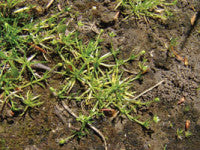Pearlwort
 Pearlwort / Sagina procumbens
Pearlwort / Sagina procumbens
Pearlwort is a perennial mat-forming plant with narrow leaves and tiny white flowers.
Pearlwort can become a troublesome weed when allowed to spread and establish in turf. This weed can populate most soil conditions very quickly by seed. Pearlwort is a good indicator of moist/wet conditions and is often mistaken for moss in lawns. Swards that are maintained at low mowing heights below 6mm (golf and bowling greens) are susceptible to invasion from this weed.
Pearlwort easily develops rooting structures from its stem nodes, producing fine roots that can invade most soil conditions.
Flowers are white, small and inconspicuous and flower from April to September. They are generally found on long stems near the tips of the branches.
Leaves are very narrow and thin, having quite a thick cuticle, which enables Pearlwort to be resistant to weed killers. The upper leaf surface is mostly smooth. Leaves are opposite and may appear whorled around the stem.
Pearlwort produces an incredible number of small seeds which can be spread by mowing and foot traffic. It also spreads as foliage grows across the soil surface, re-rooting at the internodes. Seedlings emerge from soil with foliage that looks identical to mature plants.
Pearlwort is commonly found in coastal areas and in areas of moist, frequently irrigated turf. It can form prostrate to mounding clumps 5cm in height, and has been sold as ground covering plant material for landscaping. 
Keep the sward dense and healthy to prevent Pearlwort establishing. It is best to eradicate it as quickly as you can, as this weed can prove difficult to control once established. Appropriate cultural management of the turf, aeration, feeding and regular mowing will ensure that the sward remains dense, reducing the opportunity of bare soil becoming a seed bed.
Spray with a systemic weedkiller that is absorbed through the leaves of the plant, the active ingredient makes its way through the cells of the plant down to the root. It kills these first and then the foliage starts to die off. Pearlwort is a persistent weed and may need further applications of weedkiller, often repeat spraying after 6-8 weeks. Apply selective broadleaf herbicides when plant growth is active.
There are a number of products available for controlling broad leaf weeds in established turf. These chemicals are best used when the weeds are actively growing, usually between April-October:
- Tritox (Contains 178g/L (16.2%w/w) MCPA 54.g/L(4.9%w/w) mecoprop-p and 15g/L (1.4%w/w) dicamba and potassium salts. Scotts.
- Intrepid 2 (Contains 20.8g/L dicamba,166g/L dichlorprop-p ans 166.5g/L MCPA). Scotts.· Greenor. (Contains: 40g/L fluroxypyr, 20g/L clopyralid and 200g/L MCPA). Rigby Taylor.
- Bastion T (Contains: 72g/L fluroxypyr and 300g/L mecoprop-p). Rigby Taylor.
- Supertox 30 (Contains 95g/L (8.8%w/w) mecoprop-p and 93.5g/L(8.7%w/w) as the diethanolamine salts). Bayer Environmental Science.
These herbicides are usually applied as a liquid using watering cans, knapsack sprayers and vehicle mounted sprayers.
